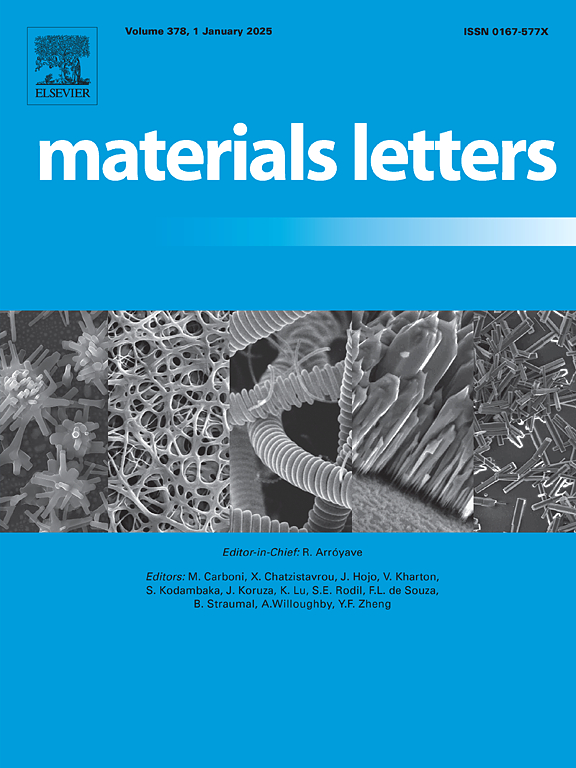Synthesis of CoCu bimetal organic frameworks for oxygen reduction reactions
IF 2.7
4区 材料科学
Q3 MATERIALS SCIENCE, MULTIDISCIPLINARY
引用次数: 0
Abstract
Developing low-cost and high-performance electrocatalysts to enhance the kinetics of the oxygen reduction/evolution reactions (ORR/OER) is crucial for energy devices, such as metal-air batteries. In this study, a pyrolysis-free method was used to prepare a series of CoCu-bimetallic organic Frameworks (CoCu-BMOFs) electrocatalysts via cooparetion of cobalt (Co) and copper (Cu) ions with 1,2,4-triazoles. The optimal Co6Cu4-BMOFs exhibited inferier ORR and OER activities in half cell comparing to commercial Pt/C + RuO2, but the maximum power density of Co4Cu6-BMOFs (268.35 mW cm−2) in Zn-air battery surpassed that of Pt/C + RuO2 (214.65 mW cm−2). Such enhancement could be attributed to the CoCu-tunable ratio in BMOFs, effectively activating the synergistic effects of Co-Nx and Cu-Nx, leading to a improved ORR/OER electrocatalytic activity. Our findings regarding the synergistic bimetallic active sites might offer a valuable path for the development of M−Nx electrocatalysts in pyrolysis-free strategy.
氧还原反应用CoCu双金属有机骨架的合成
开发低成本、高性能的电催化剂来提高氧还原/析出反应(ORR/OER)的动力学对金属-空气电池等能源设备至关重要。本研究采用无热解的方法,通过钴(Co)和铜(Cu)离子与1,2,4-三唑的协同作用,制备了一系列cocu -双金属有机骨架(CoCu-BMOFs)电催化剂。最佳Co6Cu4-BMOFs在半电池中的ORR和OER活性低于商用Pt/C + RuO2,但其在锌空气电池中的最大功率密度(268.35 mW cm−2)超过了Pt/C + RuO2的最大功率密度(214.65 mW cm−2)。这种增强可能归因于BMOFs中cocu可调比例,有效激活Co-Nx和Cu-Nx的协同效应,从而提高了ORR/OER电催化活性。我们关于协同双金属活性位点的发现可能为开发无热解的M−Nx电催化剂提供了一条有价值的途径。
本文章由计算机程序翻译,如有差异,请以英文原文为准。
求助全文
约1分钟内获得全文
求助全文
来源期刊

Materials Letters
工程技术-材料科学:综合
CiteScore
5.60
自引率
3.30%
发文量
1948
审稿时长
50 days
期刊介绍:
Materials Letters has an open access mirror journal Materials Letters: X, sharing the same aims and scope, editorial team, submission system and rigorous peer review.
Materials Letters is dedicated to publishing novel, cutting edge reports of broad interest to the materials community. The journal provides a forum for materials scientists and engineers, physicists, and chemists to rapidly communicate on the most important topics in the field of materials.
Contributions include, but are not limited to, a variety of topics such as:
• Materials - Metals and alloys, amorphous solids, ceramics, composites, polymers, semiconductors
• Applications - Structural, opto-electronic, magnetic, medical, MEMS, sensors, smart
• Characterization - Analytical, microscopy, scanning probes, nanoscopic, optical, electrical, magnetic, acoustic, spectroscopic, diffraction
• Novel Materials - Micro and nanostructures (nanowires, nanotubes, nanoparticles), nanocomposites, thin films, superlattices, quantum dots.
• Processing - Crystal growth, thin film processing, sol-gel processing, mechanical processing, assembly, nanocrystalline processing.
• Properties - Mechanical, magnetic, optical, electrical, ferroelectric, thermal, interfacial, transport, thermodynamic
• Synthesis - Quenching, solid state, solidification, solution synthesis, vapor deposition, high pressure, explosive
 求助内容:
求助内容: 应助结果提醒方式:
应助结果提醒方式:


